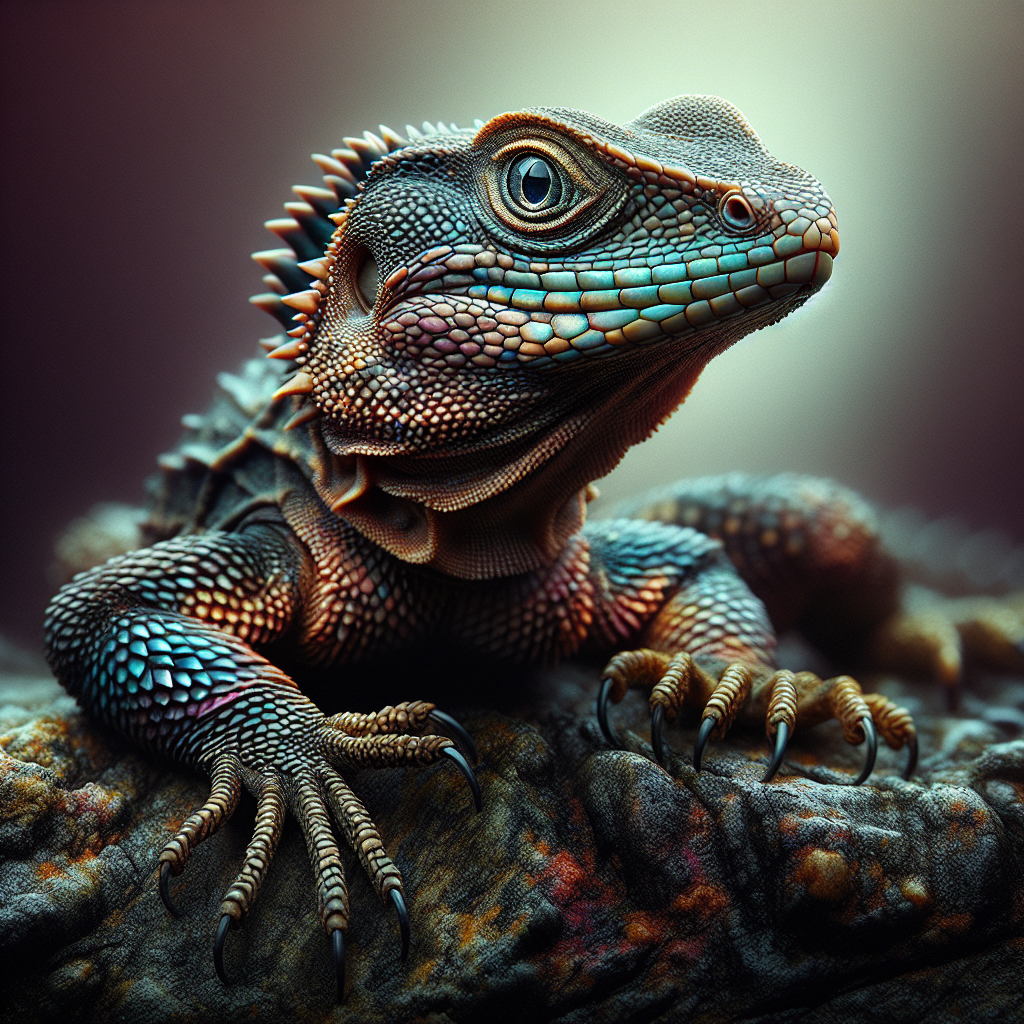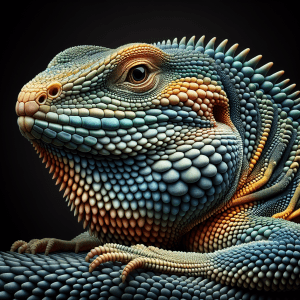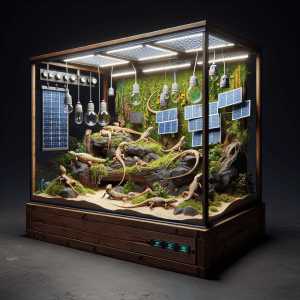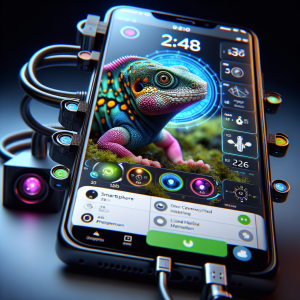Introduction: Understanding the Importance of UVB Exposure for Lizards
I remember the first time I learned about the importance of UVB exposure for lizards. It was during a visit to a reptile sanctuary, where I was amazed to see how crucial proper lighting is for the health and well-being of these fascinating creatures.
Did you know that lizards, just like humans, need exposure to ultraviolet B (UVB) light to help them synthesize vitamin D3 and maintain healthy bones? It’s a fascinating fact that highlights the intricate relationship between these reptiles and their environment.
Understanding the significance of UVB exposure for lizards opens up a world of possibilities when it comes to caring for these unique pets. From choosing the right UVB exposure system to setting it up correctly, there are plenty of considerations to keep in mind to ensure your lizard thrives in captivity.
One practical tip I can offer is to research the specific UVB requirements of your lizard species. Different types of lizards have varying needs when it comes to UVB exposure, so it’s essential to tailor your lighting setup accordingly. By providing the right amount and quality of UVB light, you can help your lizard stay healthy and active.
Have you ever wondered how UVB exposure systems have evolved over the years to meet the needs of pet lizard owners? It’s interesting to explore the advancements in technology that have made it easier than ever to create a naturalistic lighting environment for these reptiles.
As we delve deeper into the world of UVB exposure systems for lizards, we’ll uncover the secrets to providing optimal care for these unique pets. Stay tuned as we explore the benefits, challenges, and everything in between when it comes to ensuring the well-being of your scaly companion through proper UVB exposure.
Benefits of Using UVB Exposure Systems for Lizards
Have you ever thought about how important it is for our scaly friends to soak up some sun? Well, let me tell you about the incredible benefits of using UVB exposure systems for lizards. Picture this: basking under the warm glow of specialized lighting, just like they would in their natural habitat. It’s like bringing a slice of the great outdoors right into their terrarium!
You know, it’s not just about creating a cozy setup for our little buddies. UVB exposure is crucial for their overall health and well-being. Just like we need Vitamin D from the sun, lizards require UVB light to help them metabolize calcium and prevent serious conditions like metabolic bone disease. It’s like their own personal sunshine that keeps them strong and vibrant.
Now, here’s an interesting fact for you: did you know that not all UVB exposure systems are created equal? There are different types available, from fluorescent tubes to mercury vapor bulbs, each offering varying levels of UVB output. Choosing the right system tailored to your lizard’s species and specific needs can make a world of difference in their quality of life.
When setting up your UVB exposure system, it’s not just a plug-and-play situation. You’ll want to consider factors like the distance of the light source from your lizard, the duration of exposure, and the proper positioning within the enclosure. It’s all about creating a cozy spot where your pet can comfortably soak up those essential UVB rays.
And here’s a practical tip for you: make sure to regularly monitor and replace your UVB bulbs according to the manufacturer’s recommendations. Over time, these bulbs lose their UVB output, so keeping them fresh ensures that your lizard is getting the full benefit of the light therapy.
So, the next time you see your lizard lounging contentedly under their UVB light, you’ll know that you’re providing them with the best care possible. After all, a happy lizard is a healthy lizard!
Types of UVB Exposure Systems Available for Lizards
When it comes to exploring the different types of UVB exposure systems available for lizards, it’s like entering a whole new world of lighting options specifically designed to cater to our scaly friends’ needs. Picture this: you walk into a reptile store, and suddenly you’re surrounded by a variety of UVB exposure systems, each claiming to be the best for your lizard buddy.
One interesting fact to consider is that not all UVB exposure systems are created equal. Some are compact, while others are linear, and each type has its own set of pros and cons. Just like us humans, lizards have unique requirements when it comes to UV light, so choosing the right system is crucial for their health and well-being.
Let’s dive a bit deeper into these systems. You have your compact UVB bulbs, which are great for smaller terrariums or specific areas within a larger enclosure. On the other hand, linear UVB fluorescent tubes are ideal for larger setups, providing a more uniform distribution of UVB across the habitat. Then there are mercury vapor bulbs, known for emitting both UVB and heat, making them a popular choice for basking spots.
Now, imagine you’re faced with the challenge of deciding which type of UVB exposure system would work best for your lizard. It can be overwhelming, right? But fret not, my friend, because I’ve got a practical tip for you. Consider your lizard’s species, size, and natural habitat when selecting a UVB exposure system. Different lizards have varying UV light requirements, so tailoring the system to match your pet’s needs is key.
As you navigate through the array of UVB exposure systems, remember that ensuring your lizard receives the right amount of UV light is not just about lighting up their home—it’s about promoting their overall health and happiness. So, next time you’re shopping for a UVB exposure system, keep these tips in mind to provide your scaly companion with the best possible care.
How to Choose the Right UVB Exposure System for Your Lizard
Imagine you’ve just brought home a new lizard and you’re excited to set up the perfect habitat for your scaly friend. One essential element you’ll need to consider is providing the right UVB exposure for your lizard’s health and well-being.
When choosing the right UVB exposure system for your lizard, it’s important to consider a few key factors. Firstly, you’ll want to determine the size of your lizard’s enclosure to ensure you select a UVB system that can adequately cover the space. Different lizards have varying requirements when it comes to UVB exposure, so researching your specific lizard’s needs is crucial.
Next, think about the type of UVB bulb that will work best for your setup. Some lizards may require a higher UVB output, while others may do well with a lower intensity. It’s also important to consider the distance between the UVB bulb and your lizard’s basking spot to ensure they are receiving the right amount of UVB rays.
One practical tip to keep in mind is to regularly monitor the UVB output of your bulb. Over time, UVB bulbs can lose their effectiveness, so it’s recommended to replace them at least every six months to ensure your lizard is getting the proper UVB exposure.
By providing your lizard with the right UVB exposure, you’re not only promoting their physical health but also supporting their natural behaviors and overall well-being. Lizards rely on UVB rays to help them metabolize calcium and maintain strong bones, making UVB exposure a crucial aspect of their care.
As you navigate the world of UVB exposure systems for your lizard, remember that each lizard species has its own unique requirements. Taking the time to research and understand your specific lizard’s needs will help you create a thriving environment where your scaly friend can bask under the right amount of UVB light for years to come.
Setting Up and Maintaining a UVB Exposure System for Your Lizard
Have you ever set up a UVB exposure system for your lizard? It can be a game-changer for their health, but getting it right is crucial. Let me tell you about setting up and maintaining a UVB exposure system for your scaly friend.
When I first got a UVB light for my bearded dragon, I thought it was a simple plug-and-play situation. Little did I know that proper setup and maintenance play a huge role in its effectiveness. To ensure your lizard reaps all the benefits of UVB exposure, you need to pay attention to a few key things.
First off, proper placement is essential. You want the UVB light to cover a significant portion of your lizard’s habitat without any obstructions. Also, make sure the light isn’t too far away from your pet – they need to be within the recommended distance to receive the right amount of UVB.
Maintaining the UVB bulb is another crucial aspect. These bulbs have a limited lifespan, so it’s important to replace them regularly as recommended by the manufacturer. Remember, even if the bulb still lights up, it may not be emitting enough UVB rays for your lizard.
One practical tip I learned along the way is to keep track of the bulb’s usage. Some bulbs come with indicators that show when it’s time for a replacement, while others require manual tracking. Creating a maintenance schedule can help you stay on top of bulb changes and ensure your lizard always gets the UVB exposure they need.
By setting up and maintaining a UVB exposure system correctly, you’re not just providing light for your lizard – you’re supporting their overall health and well-being. So, next time you’re taking care of your scaly companion, remember that a little UVB goes a long way in keeping them happy and healthy.
Common Mistakes to Avoid When Using UVB Exposure Systems
You know, setting up and maintaining a UVB exposure system for your lizard may seem straightforward at first, but there are some common mistakes that many lizard owners make without realizing it. Take my friend Sarah, for example. She was so excited to get a UVB system for her bearded dragon, but she didn’t realize that proper placement of the lights is crucial. She initially placed the UVB bulb too far away from her dragon’s basking spot, which meant her pet wasn’t getting the optimal UVB exposure it needed.
One interesting fact about UVB exposure systems for lizards is that the distance between the UVB bulb and your lizard can significantly impact the effectiveness of the system. If the light source is too close, it can cause burns or stress to your lizard. On the other hand, if it’s too far away, your lizard may not receive enough UVB radiation to synthesize vitamin D3, which is essential for calcium metabolism and overall health.
To avoid common pitfalls like Sarah’s, it’s essential to ensure that the UVB bulb is placed at the correct distance and angle from your lizard’s basking spot. Additionally, regularly check the manufacturer’s guidelines for the recommended distance and replace the UVB bulb as per the recommended schedule to maintain its effectiveness.
By being mindful of these factors and taking the time to set up and maintain your UVB exposure system correctly, you can ensure that your lizard receives the necessary UVB radiation for its health and well-being. Remember, a little attention to detail can go a long way in providing the best care for your scaly companion.
Tips for Maximizing the Effectiveness of UVB Exposure for Lizards
Have you ever wondered how to make the most out of UVB exposure for your pet lizard? Let me tell you, it’s not just about having the right lighting system; there are some tricks that can really boost its effectiveness!
One thing that many lizard owners overlook is the importance of adjusting the height of the UVB bulb. You see, the intensity of UVB rays decreases with distance, so it’s crucial to position the bulb at the right height to ensure your lizard is getting the optimal amount of UVB exposure. Too close, and your lizard might get burned; too far, and it won’t be getting enough UVB to stay healthy.
Another tip that can make a big difference is ensuring that there are no barriers blocking the UVB rays from reaching your lizard. This means keeping the enclosure clean and free of any obstructions that could potentially block the light. It’s like making sure your lizard gets a nice, even tan – but without the risk of sunburn!
Now, here’s a fun fact for you: did you know that some lizards are more UVB-sensitive than others? That’s right! Different species have different requirements when it comes to UVB exposure, so it’s essential to do your research and know what’s best for your specific type of lizard. Just like how some people can spend hours in the sun without burning, while others turn into lobsters after just a few minutes!
By following these simple tips and understanding the unique needs of your lizard, you can ensure that your pet is getting the right amount of UVB exposure to stay healthy and happy. It’s all about creating the perfect environment for your scaly friend to thrive and bask in the glow of good health.
Recommended UVB Exposure Systems for Different Types of Lizards
Have you ever wondered how different types of lizards require specific UVB exposure systems tailored to their needs? It’s like choosing the right pair of sunglasses for a sunny day – essential for their well-being and vitality. When I was setting up a UVB exposure system for my bearded dragon, I quickly realized that not all systems are created equal.
Did you know that certain lizard species, such as bearded dragons or leopard geckos, have varying UVB requirements based on their natural habitats? This interesting fact highlights the importance of selecting the appropriate UVB exposure system to mimic the sunlight conditions they would experience in the wild. It’s like bringing a piece of their natural environment into their habitat to support their health and development.
One practical tip I learned along the way is to research the specific UVB needs of your lizard species before investing in an exposure system. Understanding the optimal UVB levels, bulb types, and fixture placements can make a significant difference in promoting your lizard’s overall health. It’s like creating a personalized tanning plan, but for your scaly friend!
As you explore the world of UVB exposure systems for lizards, consider how these systems contribute to the broader well-being of your pet. Providing the right amount of UVB light can enhance their immune function, regulate calcium metabolism, and even influence their behavior. It’s like giving them a daily dose of sunshine to thrive in captivity.
So, next time you’re setting up a UVB exposure system for your lizard, remember to tailor it to their specific needs, consider the natural UVB requirements of their species, and consult with a reptile specialist if needed. Your lizard will thank you with vibrant colors, healthy growth, and a happy basking spot under their UVB light.
Understanding the Relationship Between UVB Exposure and Lizard Health
You know, it’s fascinating to think about how something as simple as UVB exposure can have such a significant impact on the health of our beloved lizards. I remember when I first learned about the importance of UVB light for reptiles, it was like a light bulb moment (pun intended!).
Did you know that UVB exposure plays a crucial role in a lizard’s overall well-being? It’s not just about providing light for them to bask in; it’s about ensuring they receive the necessary UV rays to help them metabolize calcium and maintain healthy bones. Without adequate UVB exposure, lizards can develop serious health issues like metabolic bone disease, which can be quite distressing for both the lizard and the owner.
When setting up a UVB exposure system for your lizard, it’s essential to consider factors like the type of lizard species you have, the size of the enclosure, and the distance between the UVB light and the basking spot. It may sound complicated at first, but with a bit of research and understanding, you can easily create the ideal environment for your scaly friend to thrive.
Have you ever wondered why some lizards seem more active and vibrant than others? Well, it could very well be attributed to their UVB exposure levels. Just like how we humans feel better on sunny days, lizards benefit greatly from receiving the right amount of UV light. It’s like giving them a little piece of their natural habitat right in your home.
So, next time you see your lizard basking under the UVB light, remember that you’re not just providing them with a source of warmth; you’re also nurturing their health and happiness. It’s a small gesture that can make a world of difference in their quality of life.
Conclusion: Ensuring the Well-Being of Your Lizard through Proper UVB Exposure
Have you ever thought about the relationship between UVB exposure and the health of your lizard? It may not be something you ponder every day, but trust me, it’s crucial! Picture this – a few months back, my friend got a new bearded dragon and was super excited about setting up its habitat. She did all the research, got the best UVB exposure system, and thought everything was perfect. However, after a while, her lizard started showing signs of poor health, like lethargy and dull skin. It turned out that the UVB exposure system she was using wasn’t providing the right amount of UVB light, affecting her pet’s health.
Understanding the significance of UVB exposure for lizards is vital to their well-being. Proper exposure to UVB light helps lizards synthesize vitamin D3, which is essential for calcium absorption and overall health. Without adequate UVB exposure, lizards can develop serious health issues like metabolic bone disease, which can be life-threatening.
When choosing a UVB exposure system for your lizard, it’s essential to consider factors like the size of your lizard’s habitat, the specific UVB requirements of your lizard species, and the quality of the UVB bulbs. Setting up and maintaining the system correctly is equally important to ensure your lizard receives the right amount of UVB light.
Now, here’s a thought-provoking question for you – have you ever wondered if your lizard is getting enough UVB exposure? It’s easy to overlook this aspect of their care, but it plays a significant role in their overall health and well-being. By investing in a quality UVB exposure system and following best practices for UVB lighting, you can ensure that your lizard thrives and enjoys a long, healthy life.




